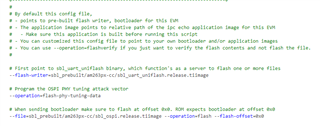Other Parts Discussed in Thread: UNIFLASH
Tool/software:
Dear TI Support Team,
I’m trying to understand the expected behavior of the AM263P4 SBL when booting from OSPI flash. The documentation generally states that the appimage should be written to address 0x80000, but in practice, the image only boots correctly when placed at 0x81000.
A few inconsistencies raise questions:
- Most documentation references 0x80000, yet this does not work.
- TI’s own tools (Python-based and Uniflash) default to 0x80000, even though booting fails at that address.
- Uniflash does not allow writing to 0x81000, it fails citing an alignment issue, while
uart_uniflash.pyanduart_uniflash_gui.pyallow setting the address manually.
Could you clarify the intended behavior? How is this supposed to work according to TI’s design? Understanding the expected workflow is crucial for resolving these inconsistencies.
Additionally, does this issue have any connection to the swap variant of the SBL? I understand that swap mode is not currently in use, but since it includes logic for selecting between variant A and B, could it be influencing the boot address in some way?
Looking forward to your clarification.
Best regards,
Jiri



